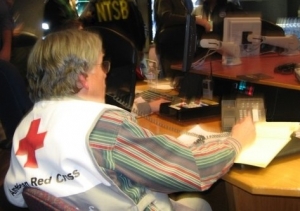Which were the top 5 disasters of 2008? Watch the video to find out…
Which were the top 5 disasters of 2008? Watch the video to find out…
Other Disaster Events - December 2008

Red Cross volunteer, Joe Callahan, coordinates mental health services for plane crash victims and their families.
On December 20, a passenger plane skidded off a runway in Denver Colorado. Charley Shimanski, CEO of the Mile High Chapter, describes the Red Cross response:
In all, 38 people were transported to five local hospitals, and the chapter responded to each of these hospitals. At [Denver International Airport], we assisted Continental [Airlines] in the establishment of a Friends and Family Reception Center (FFRC). This was staffed with Health Services, Mental Health, and Mass Care volunteers. The FFRC helped to link families back together from the incident.
The families that were traveling to Houston and in need of lodging were bussed to a local hotel by Continental, and the two Red Cross Mental Health Care professionals that had been at [Denver International Airport] after the incident stayed the night at the hotel with those passengers. Our Mental Health Care professionals also accompanied those passengers back to Houston the following morning on the Charter aircraft that Continental provided.
It is widely known that the Red Cross offers basic health services, sheltering, and food in times of need. Many people, however, do not realize that the Red Cross responds to aviation incidents, provides services to family members, and offers mental health counseling immediately after traumatic events.
Disasters are traumatic. Red Cross workers are specially trained to identify and address need as well as trauma that disaster victims and their families experience.
You can become a Red Cross volunteer by contacting your local chapter.
Winter Storms - December 2008
Register as Safe & Well and check out preparedness information for before, during, and after a winter storm:
Winter Storms - December 2008
These photos are available for media distribution. Please click the photo for caption and courtesy information:
Lisa Michaud reports from New Hampshire:
LisaMichaud’s Mobile post sent by AmRedCross using Utterli. Replies. mp3
Winter Storms - December 2008
As of this morning, there were 13 Red Cross shelters opened in 7 counties in Northeast New York.
Map of shelters located in Northeast New York:
With high winds expected to continue, power outages are expected to rise. Here are some safety tips for blackouts:
More information:
Winter Storms - Release - December 2008
![]()
The American Red Cross sheltered hundreds of people over the weekend who were affected by ice storms in the Northeast. Working with local partners, Red Cross chapters opened shelters in Maine, Massachusetts, New Hampshire, New York and Vermont.
“Unfortunately, ice storms are par for the course during the New England winter. But the Red Cross is always ready to give people a safe and warm place to go when there are widespread power outages like this,” said Joe Becker, senior vice president of Disaster Services.
Severe winter weather also threatens other parts of the country this week, including states in the Midwest and West.
The Red Cross encourages everyone to be prepared:
Avoid traveling by car in a storm, but if you must, make sure you have a disaster supplies kit in the trunk. Keep your car’s gas tank full for emergency use and to keep the fuel line from freezing. Let someone know your destination, your route and when you expect to arrive.
If you get stuck while driving: